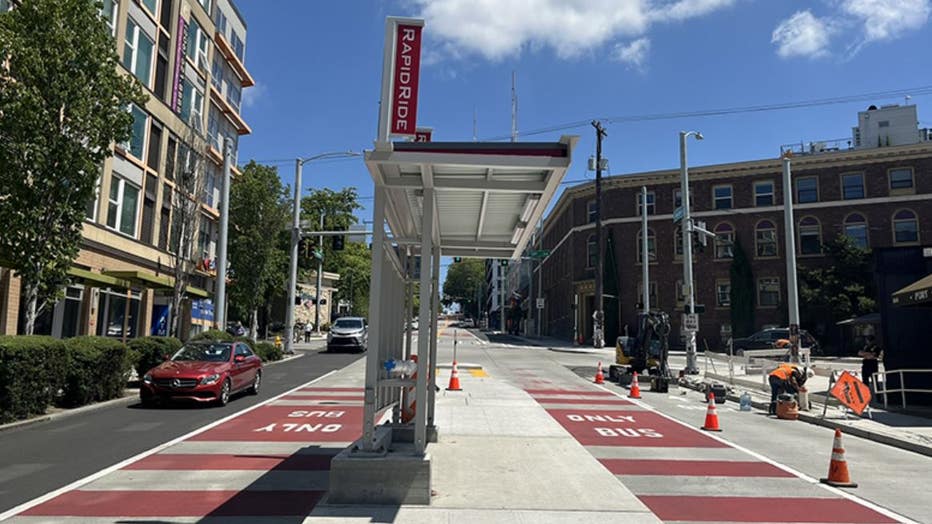Seattle's RapidRide G Line launches just in time for Apple Cup

Seattle's RapidRide G Line officially launches
Seattle?s new RapidRide G Line is now up and running, connecting some of the city?s busiest neighborhoods.
SEATTLE - Seattle’s new RapidRide G Line is now up and running, connecting some of the city’s busiest neighborhoods just in time for the Apple Cup game at Lumen Field.
The launch on Saturday marks the completion of one of the Seattle Department of Transportation’s (SDOT) largest and most ambitious transit projects, designed to provide frequent and reliable public transit along Madison Street.
The RapidRide G Line, operated by King County Metro, will run every six minutes throughout most of the day, offering a major boost in connectivity between downtown Seattle, Capitol Hill, First Hill the Central District and Madison Valley. The service aims to ease congestion and reduce travel time with dedicated bus lanes, priority signals, and modern bus stops, including center-running stations to facilitate quicker boarding.
"This project is a huge step forward in Seattle’s public transit infrastructure," said an SDOT spokesperson. "It’s designed not just to move more people, but to make the streets safer and more accessible for everyone, including pedestrians and cyclists."

On Sept. 14, Seattle’s new RapidRide G Line will be up and running, connecting some of the city’s busiest neighborhoods. (Seattle Department of Transportation)
Key features and benefits
- Frequent service: With buses arriving every six minutes during peak hours, the G Line offers one of the most frequent transit services in the region.
- Dedicated lanes: The new route includes 1.4 miles of dedicated bus lanes, ensuring that buses can bypass general traffic and maintain reliable schedules.
- Improved accessibility: New sidewalks, curb ramps, crosswalks and curb bulbs have been installed along the route to enhance pedestrian access and safety.
- Sustainable transit: The RapidRide G Line supports Seattle’s sustainability goals by encouraging more residents to choose public transportation over driving, contributing to reduced greenhouse gas emissions.
The timing of the G Line’s launch is particularly significant as it coincides with the Apple Cup game at Lumen Field, where thousands of fans are expected. The new line is anticipated to ease travel to and from the game, providing a convenient and efficient alternative to driving in downtown traffic.
The RapidRide G Line project was made possible through a collaboration between SDOT, King County Metro, and various other partners, including federal funding from the Federal Transit Administration, Sound Transit, and support from Seattle City Light and Seattle Public Utilities.
"I walk out of my house, a block away, get on a bus and get where I need to go, so it’s very exciting and freeing and I'm really happy about it," said Jace Van Kleeck, who rode the bust from First Hill.
The project has been a decade in the making, beginning as part of the Seattle Transit Master Plan in 2012. Madison Street was identified as a crucial corridor needing enhanced transit service due to its high density of businesses, medical facilities, and residential areas.
"At the end of the day, it’s all about connection and community. Rapid transit connects us to one another, and then local small businesses provides the places where we can eat, drink, shop, celebrate and be with one another to build community," said Laura Clise, founder and CEO of Intentionalist.
Residents can expect a significant improvement in their daily commutes, with faster and more reliable connections to essential services such as schools, hospitals, and shopping districts.
"This is about making really frequent reliable connections, from hospital appointments on First Hill, to entertainment options in the Capitol Hill area, to peoples' homes in the Central District," said Pierce Canser, program director for King County Metro's RapidRide.
However, some are not as optimistic about the G-Line, including former city councilmember and chair of Seattle's Transportation Committee Alex Pederson. He provided FOX 13 Seattle with the following statement:
"The letter ‘G’ must stand for Gridlock and Gluttonous because this overly complex, overly disruptive, and over-priced project is another reason why Seattle should vote to reject and redo the Prop 1 transportation tax this November. For nearly three years, commuters, small businesses, and students suffered torn up streets, ripped out trees, and confusion — and what did they get after City Hall went over budget and the project ballooned to 150 million? We got fewer bus stops, worse traffic congestion, and a bus ride that’s just a tiny bit faster, while streets throughout our city remain unpaved, bridges unfixed, and sidewalks unavailable."
For more information on schedules and stops, visit King County Metro’s RapidRide website.
MORE NEWS FROM FOX SEATTLE
Green River Killer Gary Ridgway booked into King County Jail
River otter pulls young child into WA water, attacks family at marina
How much does it really cost to go to the WA State Fair? We found out
30-year mortgage rates hit lowest level in 19 months, Seattle rents rise
Seattle market sees rise in home listings, higher prices
To get the best local news, weather and sports in Seattle for free, sign up for the daily FOX Seattle newsletter.

